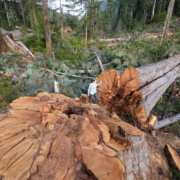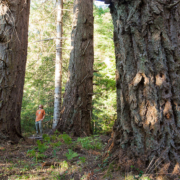Hupacasath First Nation calls on BC Government to Halt Logging of Old-Growth Forest in Nahmint Valley on Vancouver Island
Efforts to halt the logging of some of Canada’s largest old-growth trees in the Nahmint Valley, approved by the BC NDP government’s own logging agency, BC Timber Sales (BCTS), have taken a leap forward with the Hupacasath band council in Port Alberni releasing an open letter calling on the BC government to “pull” the old-growth cutblocks and to work collaboratively with the band to ensure the protection of the area’s old-growth forests, biggest trees, and monumental cedars.
The logging of over 300 hectares of ancient forest in the Nahmint Valley has resulted in overwhelming criticism of the BC NDP government for planning and auctioning off the old-growth forest cublocks through BC Timber Sales.
In an open letter from Band Council Chief Steven Tatoosh received by the AFA last week, the Hupacasath Nation expressed concerns about the recent, “unnecessary” harvesting of old-growth in their traditional territory, which, as Tatoosh stated, contradicts the NDP’s 2017 election platform and undermines government to government consultation with the Hupacasath Nation.
The letter, addressed to the Ministry of Indigenous Relations and Reconciliation, calls on the BC government to immediately extinguish all approved cutblocks in the Nahmint Valley and to collaborate with the Hupacasath First Nation to review existing licenses and establish “best management practices for coastal legacy, monumental, and old-growth trees” in Hupacasath traditional territory, which have “immense cultural, spiritual and emotional value” to the Hupacasath Nation.
Hupacasath band member, Brenda Sayers, has spearheaded a group of band members working on developing solutions for protecting old-growth forests in their territory. Sayers was recently featured in a video documentary clip by the Ancient Forest Alliance which can be seen at: https://www.youtube.com/watch?v=Sw4BToE48Ew&t=2s
“We support the Hupacasath First Nation band in their request to the BC government to halt BC Timber Sales’ plans for logging of some of Canada’s largest and oldest trees,” stated Andrea Inness, Ancient Forest Alliance campaigner. “We also encourage the provincial government to move forward on its commitment to modernize land use planning in partnership with First Nations, and we urge the government to pair that process with funding for the sustainable economic development and diversification of First Nations communities in lieu of old-growth logging.”
Old-growth logging in the Nahmint Valley has continued through much of the summer, despite the major public outcry, including major media coverage and viral social media attention, after the Ancient Forest Alliance and local Port Alberni conservationists uncovered the logging of some of Earth’s grandest ancient forests and near record-sized trees – including the felling of what was the ninth widest Douglas-fir tree in Canada – in the Nahmint Valley in May (see AFA press releases here and here).
Maps obtained from BCTS show planned future logging throughout the valley, including in two large areas within an intact section of forest on the west side of Nahmint Lake; the slope below the west side of Gracie Lake, adjacent to an Ungulate Winter Range forest reserve; a low slope west of Nahmint Mountain; and on the northern slope at the upper end of the valley.
“British Columbians are outraged by the logging of endangered ancient forest ecosystems that’s taking place in the Nahmint Valley – and throughout many regions of BC – and are speaking out strongly in favour of old-growth protection,” stated Ancient Forest Alliance campaigner TJ Watt. “Thousands of concerned people have sent messages to the BC government, asking them to implement science-based policies to protect old-growth while ensuring a sustainable, second-growth forest industry. Unfortunately, so far it seems the NDP government would prefer to stick its head in the sand, engage in PR-spin, and carry on with business as usual.
The Ancient Forest Alliance is encouraging BC residents to continue to express their views to the BC government on old-growth logging, including in the Nahmint Valley, and on the need for interim protections for intact areas while science-based solutions and old land use plans are modernized to include First Nations land use plans.
“The Ministry of Forests says it intends to hold a public comment period on the new logging plans for the Nahmint Valley sometime soon,” stated Inness. “It will be a good opportunity for British Columbians to speak up to BC Timber Sales, forests minister Doug Donaldson, and Premier Horgan, calling on the NDP government to direct BCTS to stop issuing cutting permits in old-growth forests and to start supporting old-growth conservation solutions instead.”
The Ancient Forest Alliance, along with Sierra Club BC and Wilderness Committee, are calling on the BC government to enact a series of policy changes, including a science-based plan to protect old-growth forests, the use of regulations and incentives to ensure a sustainable, value-added, second-growth forest industry, and financial support for the sustainable economic diversification of First Nations communities linked to their development of land use plans that protect old-growth forests.
Background Information
Old-growth forests are vital to sustaining unique endangered species, climate stability, tourism, clean water, wild salmon, and the cultures of many First Nations. On BC’s southern coast, satellite photos show that at least 75% of the original, productive old-growth forests have been logged, including well over 90% of the valley bottoms where the largest trees grow. Only about 8% of Vancouver Island’s original, productive old-growth forests are protected in parks and Old-Growth Management Areas. Old-growth forests, with trees that can be 2000 years old, are a non-renewable resource under BC’s system of forestry, where second-growth forests are re-logged every 50 to 100 years, never to become old-growth again.
The Nahmint Valley is considered a “hotspot” of high-conservation value old-growth forest by conservation groups, with some of the largest tracts of remaining old-growth forests on Vancouver Island outside of Clayoquot Sound, and is home to Roosevelt elk, black-tailed deer, cougars, wolves, and black bears, as well as old-growth associated species like the marbled murrelet and northern goshawk. The area also supports significant salmon and steelhead spawning runs. The Nahmint is considered by many people to be one of the most scenic areas in BC, with its ancient forests, rugged peaks, gorgeous turquoise canyons and swimming holes, and large and small lakes, and is heavily used by hikers, campers, anglers, and hunters.The Nahmint Valley is located in the territories of the Hupacasath and Tseshaht First Nations.
The BC government has often stated that “over 55% of Crown old-growth forests on B.C.’s coast are protected,” but fails to mention that the vast majority of coastal old-growth forests are protected in the Great Bear Rainforest, not on Vancouver Island where old-growth logging occurs at a scale of about 11,000 hectares a year (in 2016). The government also claims that, “on Vancouver Island, over 40% of Crown forests are considered old growth, with 520,000 hectares that will never be logged;” however,these figures leave out the approximately 800,000 hectares of heavily logged-over private forest lands on Vancouver Island (which are still managed under provincial authority). The 520,000 hectares they reference also includes about 360,000 hectares of low-productivity forest (i.e. stunted, marginal forests that grow in bogs, on steep rocky mountainsides, and in the high sub-alpine zones where the trees are smaller and generally of low to no commercial value). Finally, the BC government fails to mention the context of how much old-growth has previously been logged: almost 80%, or about 16 million hectares of the original 20 million hectares, of productive old-growth forest on Vancouver Island and over 90% of the low elevation, high-productivity stands (i.e. the very rare “classic” monumental stands of giants being logged in the Nahmint right now).
BC Timber Sales (BCTS), a division of the Ministry of Forests, Lands, Natural Resource Operations and Rural Development, is the BC government’s logging agency that plans and directly issues logging permits for about 20 per cent of the province’s merchantable timber on Crown lands, which fall outside of forestry tenures. The BC government retains full control over which cut blocks are auctioned each year through BCTS and can therefore use this control to quickly phase out issuing timber sales in old-growth forests in these areas.
“The forests minister assures us that sufficient old-growth is protected in the Nahmint Valley, but it’s a question of quality, not just quantity,” stated Andrea Inness, AFA campaigner. “Most of the valley’s monumental groves, growing at lower elevations on the richer sites, have long since been logged and much of the remaining old-growth forests outside of current approved and planned cutblocks are comprised of smaller trees growing on low and medium productivity sites, including most of the forests protected in forest reserves. The BC government is skewing the numbers to hide the fact they’re auctioning off the grandest forests with the biggest trees while protecting forests of much lower commercial value that often lack the biodiversity of the richer, grander stands.”
“Fortunately, it’s not too late for the Nahmint Valley,” stated TJ Watt, AFA campaigner. “There are still significant tracts of old-growth forest left in the area and very high environmental and recreational values that are worth protecting. The BC government has an opportunity right now to turn things around and do the right thing, for which they will certainly gain public approval.”




